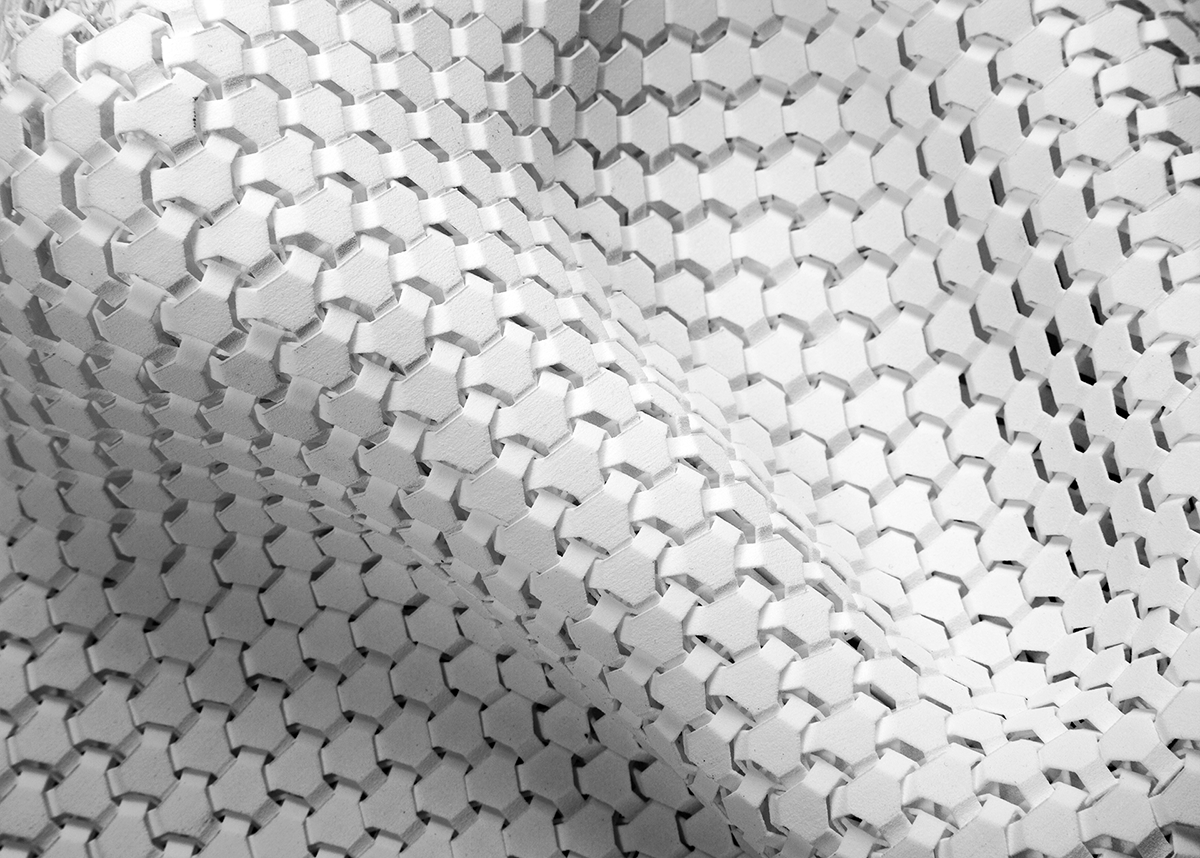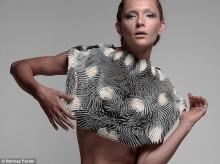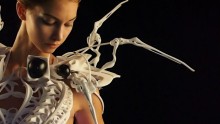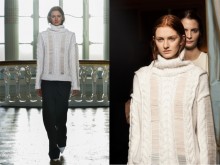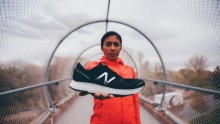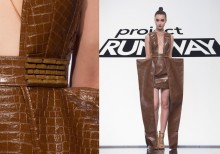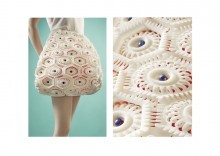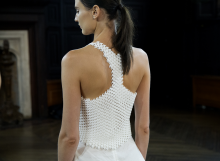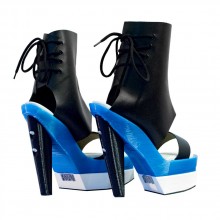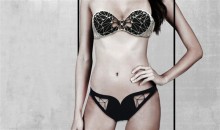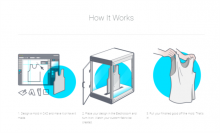3D Printed Clothes: Fashion Designers create wearable garments
Posted By Claire Chabaud on Jan 27, 2016 | 1 comment
2015 was a paradoxical year for the fashion industry and 3D printing. Indeed, this year is a mix between disruptive applications (pushing the boundaries of 3D printing one step beyond) and in the meantime the use of 3D printed accessory became a commonplace. The future of 3D Printing in the fashion industry is even written: sur-mesure and dematerialization are the ultimate challenges. But we should keep it in mind as a dream in 2016. From international brand implementing 3D printed parts in their clothes to fully dematerialized outfits, there is a wide gap. Then, what is really at stake with the 3D Printing technology in this industry ?
Have you ever worn clothes made on demand for you? It’s so comfortable! It’s nowadays an experience out-of-a kind, even if it was a commonplace a century ago. Good news: one of the 3D Printing promises is to make this experience affordable for everyone, and a lot of people are working to make it true. To have the best insight to understand how 3D printing might shape the future of our clothes we are going to approach 2 main aspects. The first one is how fashion designers are using this technology. The second one is an overview of the challenges the technology will have to take up to avoid the current bottlenecks.
How Fashion designers are using this technology
Due to their singular vision, fashion designers are not implementing 3D printing in the same way. If you want to understand what are the main differences, we could create 3 categories according to their various ideas.
-
The Iris Van Herpen’ category
When you see an Iris Van Herpen creation for the first time, after the silent astonishment the first word that should come to your mind is “ How?”. This Fashion designer is really putting the technology at the core of her creation process. Most of her collection looks like it was the exact replicas of her imagination no matter if it looks unrealistic. To temper this statement, she also creates more wearable outfits, but the most creative ones are the ones why she is best known for.
Translating the vision of this designer in a few words could be “ 3D printing materializes my vision”. Using 3D printing for the shape you have in mind enhances all the artistic aspects, but does not necessarily take into account the practical clothing part such as “ could I actually wear it?”. As a summary this category is characterized by really creative and disruptive clothes and a vision of 3D printing as an inherent part of their creations.
For example in this category you will find:
- The “Caress of the Gaze” from the creator Behnaz Farahi, is an interactive 3D printed wearable, which can detect other people’s gaze and respond accordingly with life-like behavior. An amazing piece to develop the concept of the augmentation of Man but not actually wearable.
- The Spider Dress of Anouk Wipprecht, has Mechanical arms extend and retract as a response to external stimuli when people approach, the wearer’s own breath will help to signal the defense posture of the robotic arms. The dress is fully 3D printed with the SLS technology.
- Also, one of the last creation of Iris Van Herpen, which was incorporated in her last show: a dress directly 3D printed on the famous game of Thrones actress, Gwendoline Christie. This installation is really impressive, as it represents a scene where the human is not needed anymore to create the clothes, only the machines are busy around the body to shape the dress.
-
The Karl Lagerfeld category
In the last show of Chanel, various pieces were 3D printed. But the effect was not the same as the collection of Iris Van Herpen. In Chanel’s Collection, 3D printing was so well mixed with classical fabric that it wasn’t obviously made with the technology. Also, Karl Lagerfeld didn’t tried to make fully 3D printed clothes. Why ? Because he mixed the technology with the traditional haute-couture savoir-faire. On the 3D printing jacket below for example, you can see that fabric and pearls had been sewed in a classical way by les ateliers lesage.
The vision of this kind of designer is that 3D printing is a disruptive technology, and you have to learn how to implement it to your process to be up to date. Still, the technology cannot replace the legacy of a know-how, then you have to find out a way to mix them together. This category is characterized by a traditional technics and a futuristic vision. 3D printing is more perceived as a new mean of production, but it’s not the final purpose of the creation
For example in this category you will find:
- Pringle of Scotland and their stunning collection of wearable 3D printed jumpers. They opted to use 3D printing elements as means to enhance and complement knitwear.
- Leading brands in the footwear industry
How to make the most of the made-to-mesure advantage of 3D printing? By scanning some singular shaped parts of your body. Then your feet are probably the most suitable to enjoy the use of the technology. And it doesn’t escape to the giant of the footwear industry who are already launched in the competition of the instantly made perfectly fitted shoe. Thus Nike, Adidas and New Balance released at the end of last year 3 prototypes of shoes with 3D printed soles. New Balance seems to lead the way as it first unveiled its prototype at the CES 2016 and announced the first sell in April 2016 in Boston. The sole is 3D printed with SLS technology in TPU (Thermoplastic Polyurethane). It’s a category of plastic created when a polyaddition reaction occurs between diisocyanate and one or more diols. They can be used as a soft engineering plastic or as a replacement for hard rubber. Then the real challenge is to create a TPU strong enough for a sole that is to say resistant to thousands of repeated impacts on the ground to make it marketable.
- Kelly Dempsey creation in the Project runway episode special 3D printing. The Project Runway is an American reality television series focuses on fashion design. The contestants compete with each other to create the best clothes and are restricted in time, materials and theme. In the special 3D printing episode, the fashion designer had to implement 3D printing in their design. Which is interesting in this example, is that 3D printing was not considered as a way to create the clothes, but a tool to enhance the creativity of the contestants by creating their own garments.The winning dress has been enlivened with 3D printed parts in the belt and the V-neckline.
- The Virus Collection designed by Anastasia Ruiz and 3D printed by Sculpteo. This collection of clothes is mixing the traditional couture savoir-faire and 3D printing with innovative material. Released at the CES 2016, the virus collection is composed of pieces with real fabric that use 3D printing as an ornament. The fashion designer wanted to designed exactly the pattern she had in mind but with the condition to keep the pieces wearable.
-
The Danit Peleg category
Danit Peleg is an amazing student who realized a 3D printed collection with home printers while she didn’t knew anything about the technology. As she learnt by herself how to use 3D printers and how to 3D design, she firmly believes that in the future we will travel without luggage and we’ll just 3D print our clothes ourselves after checking in at the hotel for example.
These fashion designers are the closest from the maker. For them 3D printing is as much disruptive in the material than in the process of creation. They are not looking to mix it with traditional fabric, they literally want to dematerialized our clothes and shape the future of the industry. Unlike the Iris van Herpen category they are focusing more on the wearable aspect of the clothes than the artistic aspects.
For example in this category you will find:
- Bradley rothenberg works in collaboration with brands as Victoria’s secret or fashion designer as to make 3D printed textile a viable and accessible reality. His work is to find how to incorporate 3D printing in the process of creation. Then he is also looking to explore the different ways to develop 3D printing in the process and the material to create fully 3D printed clothes. His last collaboration with Katie Gallagher for her SS15 collection is a telltale example of his progresses. Also his ongoing project with cellular textiles sounds very promising.
- Bryan Oknyasnky Shoes. This fashion designer succeed to create fully printed, customizable, wearable and already marketable shoes. You can have a look or buy your first pair on his website.
These fashion designers are leading the way to explore the different paths of applications for 3D printing in the future. Personally, I think that when it comes to technology and fashion, it’s important to remember these words of Coco Chanel :
“A fashion that does not reach the streets is not a fashion.”
If the technology doesn’t make the clothes wearable, then we are more talking about art than fashion. Through, the 3 categories of Fashion designers we can say that 2015 was a telltale example of this quote. The innovation this year was to find out how to implement 3D printing in a practical and marketable way. Even if some progresses were made, there is still many points to improve.
The challenges the technology will have to take up
Then what are the key objectives to reach for 3D printing to be fully incorporated in the fashion industry?
1. Eco-friendly
If 3D printing should be the new way to manufacture our clothes, then it should from the start take into account the ecological challenge it implies. From the process of printing to the material, it’s important that all the steps tend to be eco-friendly and create a biodegradable product.
- A surprisingly amazing project in this idea is the Sponge suit a 3D printed eco-bikini made by UC riverside engineering professor Mihri Ozkan. The concept is while you are swimming wearing this swimsuit you help clean the oceans. The engineer and his wife created a new material called “ Sponge” which can absorb pollutants present in the water yet, don’t put them in contact with you skin and protect it.
- Also the Recycl3-D spring collection, a sustainable 3D clothing line created by a student of Cornell university’s College of Human Ecology is a good hint to understand how 3D printing could participate to create a more responsible fashion. The clothes of her collection are 3D printed but above all recyclable! The concept lies in a multipurpose clothing that can morph in a different one by adding sleeves, pockets or even a hoods.
2. User-friendly technology
Using the 3D printing technology implies to get at first a 3D file, that is to say, to know how to 3D design. Easy Peasy, you think? Well, even Iris Van Herpen has to admit that “ I always work together with an architect because I am not good with the 3D programs myself” according to Forbes. 3D modeling is a key problematic to realise the vision where anyone could 3D print the clothes he/she wants. The solution might be for the fashion designers to create the 3D files and then to directly sell them so people will “just” have to 3D print them. It’s the path chosen by Continuum, which oversees an expanding database of clothing design files that people can download to their computer, at no cost, and print out at home if they own a 3-D printer. This solution is the most likely even if it still raise numerous questions on the copyrights.
3. Material
The current materials used by the designer are nothing like classic fabric in their physical aspect but also in their technical properties ( Did you ever try to put in your washing machine 3D printed plastic parts?). TPU is the one who has the most lookalike technical properties with its flexibility and resistant aspect but is still a plastic material. To compensate this aspect the fashion designer use their creativity to create interlocked pattern to recreate the shape and the aspect of fabric. Still, this is not an optimal solution to create daily wearable and washable clothes.
The most interesting ongoing researches on this aspect are made by Electroloom and Tamicare. Both companies are developing patents to 3D print textile. These researches are for the moment very confidential but the first samples made were encouraging.
These actors would definitely be determinant to realize the vision of instant 3D printed clothes and most of all to overcome the limit of the washable aspect.
4. Affordability
Depending on the way to modeling your project, the material and the technology used the price of 3D printed clothing is high, even for made to measure pieces. Also in 3D printing, whether you print one piece or a thousand there is only a slight cost reduction, as each piece is produced as a unique one. Then increase the affordability of this manufacturing process by using for example less expensive machines and materials will be a sine qua none condition for the development of the technology in this industry and to move from a prototype to a final product.
Eventually, 2015 was a promising start to explore new way to use 3D printing. It was also a breaking point with the mere astonishment toward the technology. As the use of 3D printing was more a commonplace, the different actors of the fashion industry started to face the real bottlenecks of the implementation of the technology. Then, will the future of the fashion industry be fully materialized with only home 3D printers? Not so sure. Still, now a brand new opportunities are in front of us, and the first progresses made are already captivating!
If you want to discover how Sculpteo can help you in your fashion project to push forward the innovation, have a look to our dedicated page here.


 Connect with Google
Connect with Google Connect with Facebook
Connect with Facebook